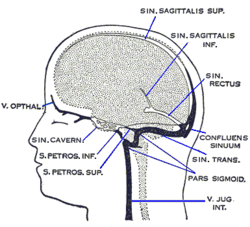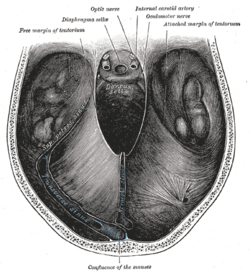Thetransverse sinuses(left and right lateral sinuses), within the human head, are two areas beneath the brain which allow blood to drain from the back of the head. They run laterally in agroovealong the interior surface of theoccipital bone.They drain from theconfluence of sinuses(by theinternal occipital protuberance) to thesigmoid sinuses,which ultimately connect to theinternal jugular vein.See diagram (at right):labeled under the brain as "SIN. TRANS."(for Latin:sinus transversus).
| Transverse sinuses | |
|---|---|
 Dural veins. (Transverse sinuses labeled as "SIN. TRANS."at center right.) | |
 Thetransverse sinusesare formed by thetentorium cerebelliand drain into the right and leftsigmoid sinuses. | |
| Details | |
| Source | Confluence of sinuses,superior sagittal sinus |
| Drains to | Sigmoid sinuses |
| Identifiers | |
| Latin | sinus transversus durae matris |
| MeSH | D054064 |
| TA98 | A12.3.05.102 |
| TA2 | 4849 |
| FMA | 50763 |
| Anatomical terminology | |
Structure
editThe transverse sinuses are of large size and begin at theinternal occipital protuberance;one, generally the right, being the direct continuation of thesuperior sagittal sinus,the other of thestraight sinus.
Each transverse sinus passes lateral and forward, describing a slight curve with its convexity upward, to the base of thepetrous portionof thetemporal bone,and lies, in this part of its course, in the attached margin of thetentorium cerebelli;it then leaves the tentorium and curves downward and medialward (an area sometimes referred to as thesigmoid sinus) to reach thejugular foramen,where it ends in theinternal jugular vein.
In its course it rests upon thesquamaof theoccipital,themastoid angleof theparietal,themastoid partof thetemporal,and, just before its termination, thejugular processof the occipital; the portion which occupies the groove on the mastoid part of the temporal is sometimes termed thesigmoid sinus.
The transverse sinuses are frequently of unequal size, with the one formed by thesuperior sagittal sinusbeing the larger; they increase in size as they proceed, from back to center.
On transverse section, the horizontal portion exhibits a prismatic form, the curved portion has a semicylindrical form.
They receive the blood from the superior petrosal sinuses at the base of the petrous portion of the temporal bone; they communicate with the veins of thepericraniumby means of themastoidandcondyloidemissary veins;and they receive some of theinferior cerebralandinferior cerebellar veins,and some veins from thediploë.
Thepetrosquamous sinus,when present, runs backward along the junction of the squama and petrous portion of the temporal, and opens into the transverse sinus.
Additional images
edit-
Left parietal bone. Inner surface.
-
Dura mater and its processes exposed by removing part of the right half of the skull, and the brain
-
The sinuses at the base of the skull
-
Horizontal section through left ear; upper half of section
-
Relations of the brain and middle meningeal artery to the surface of the skull
-
Left temporal bone showing surface markings for the tympanic antrum (red), transverse sinus (blue), and facial nerve (yellow)
-
Transverse sinuses
-
Transverse sinuses
See also
editReferences
edit- This article incorporates text in thepublic domainfrompage 657of the 20th edition ofGray's Anatomy(1918)
External links
edit- Cerebral Venous Sinusesat neuroangio.org